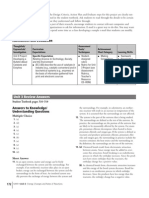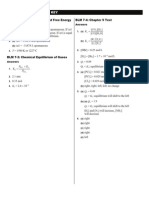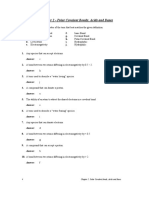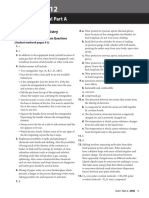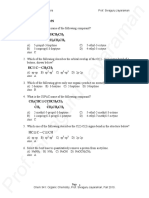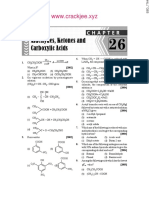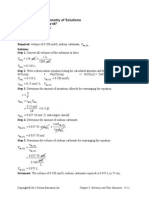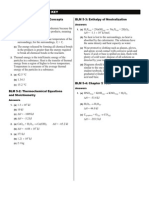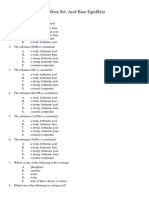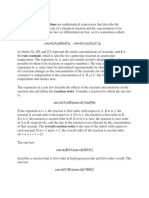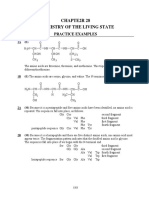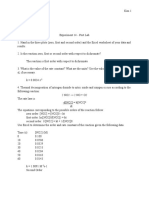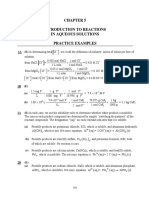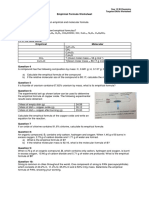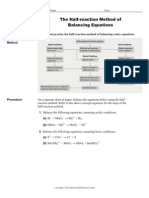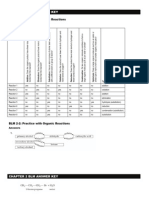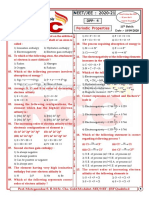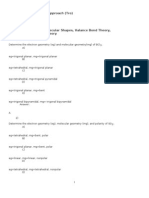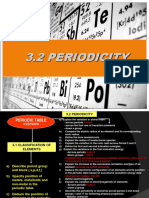Chapter 4
Chapter 4
Uploaded by
helloblargOriginal Description:
Copyright
Available Formats
Share this document
Did you find this document useful?
Is this content inappropriate?
Report this DocumentCopyright:
Available Formats
Chapter 4
Chapter 4
Uploaded by
helloblargCopyright:
Available Formats
CHEMISTRY 12
Chapter 4
Structures and Properties of Substances
Solutions for Practice Problems
Student Textbook pages 165166
1. Problem (a) (b) (c) (d)
Write electron congurations for the following: Li+ Ca2+ Br O2
Solution First determine the atomic number of the ion, and then add or subtract electrons to match the charge indicated on the ion. Use the aufbau process to write the complete electron conguration of the ion. (a) Li+ : Z = 3, subtract one electron for +1 charge; 1s 2 (b) Ca2+ : Z = 20, subtract two electrons for +2 charge; 1s 22s 22p 63s 23p 6 (c) Br : Z = 35 , add one electron for charge of 1; 1s 22s 22p 63s 23p 64s 23d 104p 6 (d) O2 : Z = 8 , add two electrons for charge of 2; 1s 22s 22p 6 Check Your Solution A check of the sequence of orbitals shows that the aufbau process was followed correctly. The number of electrons in each electron conguration matches the difference of Z (net charge on ion). The answers are correct.
2. Problem
Draw Lewis structures for the chemical species in question 1. Solution In a Lewis structure, the nucleus and the inner core electrons are represented by the symbol for the element. The electrons in the valence shell are drawn around the symbol. 2 + 2+ (a) Li (b) Ca (c) Br (d) O
Check Your Solution Each positive ion shows no electrons. This is expected, since electrons were removed from the valence shell. Each negative ion has 8 valence electrons. This is expected for all ions except helium-like ions.
3. Problem
Draw orbital diagrams and Lewis structures to show how the following pairs of elements can combine. In each case, write the chemical formula for the product. Solution In each example, electrons are transferred from the metal to the non-metal so that each ion attains a noble gas electron conguration.
Chapter 4 Structures and Properties of Substances MHR
36
CHEMISTRY 12
(a) Lewis structure:
Li
Li
Li
Li
Li
1s
2s
S2
1s
2s
2p
3s
3p
Li
1s
2s
(b) Lewis structure:
Ca
Cl
Cl
Ca
2+
Cl
Cl
Li+
Cl
1s
2s
2p
3s
3p
Ca
Ca2+
1s
2s
2p
3s
3p
4s
Cl
1s
2s
2p
3s
3p
(c) Lewis structure:
K +
K
Cl
Cl
1s
2s
2p
3s
3p
4s
Cl
1s
2s
2p
3s
3p
(d) Lewis structure:
Na Na +
Na
Na
Na
Na
Na
1s
2s
2p
3s
Na
1s
2s
2p
3s
Na
1s
2s
2p
3s
N3
1s
2s
2p
Check Your Solution In each case the ions have a noble gas electron conguration that takes into account the charge on the ion. The answers are correct.
Chapter 4 Structures and Properties of Substances MHR
Na+
Na+
Na+
1s
2s
1s
2s
1s
2s
1s
2s
1s 2s 2p 3s 3p 2p 2p 2p 2p
Cl
1s 2s 2p 3s 3p
K+
1s 2s 2p 3s 3p
Cl
1s 2s 2p 3s 3p
1s 2s 2p 3s 3p
1s 2s 2p 3s 3p 1s
1s
Li+
Cl
37
CHEMISTRY 12
4. Problem (a) (b) (c) (d)
To which main group on the periodic table does X belong? MgX X2SO4 X2O3 XCO3
Solution Since these compounds are all ionic, the zero sum rule applies, and the sum of the charges on the ions must equal zero. Once you know the charge on the ion, it can be related to the characteristic charge on ions for the main group elements. (a) The charge on Mg is +2. Therefore, (+2) + x = 0, and x = 2. X2 will be in group 16. (b) The charge on SO4 is 2. Therefore, 2(x) + (2) = 0, and x = +1. X+ will be in group 1. (c) The charge on O is 2. Therefore, 2(x) + 3(2) = 0, and x = +3. X3+ will be in group 3. (d) The charge on CO3 is 2. Therefore, x + (2) = 0, and x = +2. X2+ will be in group 2. Check Your Solution In each case the zero sum rule holds. The charge on each X ion has been determined correctly.
Solutions for Practice Problems
Student Textbook pages 169170
5. Problem
List the following compounds in order of decreasing bond energy: H H Cl. Use Appendix E to verify your answer.
Br, H
I,
Solution Since all bonds are electrical in nature, a greater difference in charge between two atoms indicates a stronger attraction between the atoms, and therefore, a stronger bond. The difference in charge can be estimated using the property of electronegativity. A greater difference in electronegativity between the two atoms in the bond indicates a greater attraction between the atoms. (A greater electronegativity also indicates a greater ionic character of the bond.) For each bond, measure the difference in electronegativity, (EN ). The greater EN, the stronger the bond. H Cl: EN = 3.16 2.20 = 0.96 H Br: EN = 2.96 2.20 = 0.76 H I: EN = 2.66 2.20 = 0.46 Based upon these calculated values for EN, H Cl has greatest bond energy and H I has the least bond energy. From Appendix E, the bond energies conrm this conclusion. H Cl: bond energy = 432 kJ/mol H Br: bond energy = 366 kJ/mol H I: bond energy = 298 kJ/mol Check Your Solution Since the measured value of bond energy matches the prediction using EN, this is a valid method to estimate bond strength.
Chapter 4 Structures and Properties of Substances MHR
38
CHEMISTRY 12
6. Problem
Rank the following compounds in sequence from lowest melting point to highest melting point, and give reasons for your decisions: AsBr3, KBr, CaBr2 . Solution When compounds that are composed of a metal ion and a non-metal ion melt, the two types of ions are separated. The greater the attraction between the ions, the more heat energy will be required to melt the compound. The attraction between ions can be estimated by calculating the difference in electronegativity (EN ) between the atoms (ions) in each bond.
AsBr3 EN = 2.96 2.18 = 0.78 KBr EN = 2.96 0.82 = 2.14 CaBr2 EN = 2.96 1.0 = 1.96
Based upon this EN, the melting points will be expected to increase from AsBr3 < CaBr2 < KBr. Check Your Answer The actual melting points of these three compounds can be found in a reference text such as the Handbook of Chemistry and Physics. A check of this reference conrms that the reasoning was correct.
7. Problem
From their position in the periodic table, predict which bond in the following groups is the most polar. Verify your predictions by calculating the EN. (a) C H, Si H, Ge H (b) Sn Br, Sn I, Sn F (c) C O, C H, C N Solution A greater distance between the positions of two elements in the periodic table indicates a greater expected difference in the atoms ability to attract electrons. Therefore, a greater distance between elements in the periodic table indicates that a more polar bond forms between the elements. Using these criteria, the most polar bond in each group is predicted to be: (a) C H (b) Sn F (c) C O Using the electronegativities given on the periodic table, the following EN are found: (a) C H (0.35), Si H (0.30), Ge H (0.19) (b) Sn Br (1.00), Sn I (0.70), Sn F (2.01) (c) C O (0.89), C H (0.35), C N (0.49) Our predictions were accurate. Check Your Solution Generally, the statement that the further apart two elements are found in the periodic table, the more polar the bond between them, is reliable. The use of EN, however, is a more accurate measure of polarity.
8. Problem
Classify the bonding in each of the following as covalent (non-polar), polar covalent, or ionic. Afterwards, rank the polar covalent compounds in order of increasing polarity. (a) S8 (b) RbCl (c) PF3 (d) SCl2 (e) F2 (f) SF2
Chapter 4 Structures and Properties of Substances MHR
39
CHEMISTRY 12
Solution Calculate the difference in electronegativity, EN, between the elements in each compound. Apply the criteria that for a mostly covalent bond, EN is < 0.5; for a polar covalent bond, EN is between 0.5 and 1.7; and for an ionic bond EN > 1.7.
EN (a) S8 (b) RbCl (c) PF3 (d) SCl 2 (e) F2 (f) SF2 00=0 3.16 0.82 = 2.34 3.98 2.19 = 1.79 3.16 2.58 = 0.58 00=0 3.98 2.58 = 1.40 Type of bonding covalent ionic polar covalent/ionic polar covalent covalent polar covalent
polar covalent compounds: SCl2 < SF2 < PF3 Check Your Solution The type of bond predicted correlates with the relative positions of the elements in the periodic table. These results are good indicators of the polarity of the bonds.
Solutions for Practice Problems
Student Textbook page 177
9. Problem (a) NH3 (e) BrO
Draw Lewis structures for each of the following molecules or ions: (b) CH4 (c) CF4 (d) AsH3 (f) H2S (g) H2O2 (h) ClNO Solution
(a) The molecular formula, NH3, gives the number of each kind of atom. Follow
steps 13 as given in the student textbook. Step 1 Nitrogen has the lower electronegativity in the molecule and will be the central atom.
H N H H
Determine the total number of valence electrons. (1 atom N 5 e/N) + (3 atoms H 1 e/H) = 8 e Determine the total number of electrons required for a noble gas conguration. (1 atom N 8 e/atom) + (3 atoms N 2 e/atom) = 14 e To nd the number of shared electrons, subtract the rst total from the second. 14 e 8 e = 6 e Divide the number of shared electrons by two to obtain the number of bonds. 6 e 2 = 3 covalent bonds Step 3 Determine the number of non-bonding electrons by subtracting the number of shared electrons from the total number of valence electrons: 8 valence e 6 bonding e = 2 e , or 1 lone pair
Step 2
N H
Chapter 4 Structures and Properties of Substances MHR
40
CHEMISTRY 12
(b) The molecular formula, CH4, gives the number of each kind of atom. Follow
steps 13 as given in the student textbook. Step 1 Carbon has the lower electronegativity in the molecule and will be the central atom.
H H C H H
Find the total number of valence electrons. (1 atom C 4 e/C) + (4 atoms H 1 e/H) = 8 e Determine the total number of electrons required for a noble gas conguration. (1 atom N 8 e/atom) + (4 atoms H 2 e/atom) = 16 e Determine the total number of electrons used in bonding. 16 e 8 e = 8 e , or 4 covalent bonds Step 3 Determine the number of non-bonding electrons. 8 valence e 8 bonding e = 0 non-bonding e
Step 2
H H C H H
(c) The molecular formula, CF4 , gives the number of each kind of atom. Follow steps Step 1
13 as given in the student textbook. Carbon has the lower electronegativity in the molecule and will be the central atom.
F F C F F
Calculate the total number of valence electrons. (1 atom C 4 e/C) + (4 atoms F 7 e/F) = 32 e Determine the total number of electrons required for a noble gas conguration. 5 atoms 8 e /atom = 40 e Determine the total number of electrons used in bonding. 40 e 32 e = 8 e , or 4 covalent bonds Step 3 Calculate the number of non-bonding electrons. 32 valence e 8 bonding e = 24 e , or 12 lone pairs
Step 2
F C
(d) The molecular formula, AsH3 , gives the number of each kind of atom. Follow Step 1
steps 13 as given in the student textbook. Arsenic has the lower electronegativity in the molecule and will be the central atom.
H As H H
Chapter 4 Structures and Properties of Substances MHR
41
CHEMISTRY 12
Calculate the total number of valence electrons. (1 atom As 5 e/N) + (3 atoms H 1 e/H) = 8 e Determine the total number of electrons required for a noble gas conguration. (1 atom As 8 e/atom) + (3 atoms H 2 e/atom) = 14 e Determine the total number of electrons used in bonding. 14 e 8 e = 6 e , or 3 covalent bonds Step 3 Determine the number of non-bonding electrons. 8 valence e 6 bonding e = 2 e , or 1 lone pair
Step 2
As H
(e) The molecular formula, BrO , gives the number of each kind of atom. Follow
steps 13 as given in the student textbook. Br O Calculate the total number of valence electrons. (1 atom O 6 e/O) + (1 atom Br 7 e/Br) + (1 e for charge on ion) = 14 e Determine the total number of electrons required for a noble gas conguration. 2 atoms 8 e/atom = 16 e Determine the total number of electrons used in bonding. 16 e 14 e = 2 e , or 1 covalent bond Step 3 Determine the number of non-bonding electrons. 14 valence e 2 bonding e = 12 e , or 6 lone pairs
Step 1 Step 2
Br
(f) The molecular formula, H2S, gives the number of each kind of atom. Follow steps
13 as given in the student textbook. Step 1 Sulfur has the lower electronegativity in the molecule and will be the central atom.
H S H
Calculate the total number of valence electrons. (1 atom S 6 e/S) + (2 atoms H 1 e/H) = 8 e Determine the total number of electrons required for a noble gas conguration. (1 atom S 8 e/atom) + (2 atoms H 2 e/atom) = 12 e Determine the total number of electrons used in bonding. 12 e 8 e = 4 e , or 2 covalent bonds Step 3 Determine the number of non-bonding electrons. 8 valence e 4 bonding e = 4 e , or 2 lone pairs
Step 2
(g) The molecular formula, H2O2 , gives the number of each kind of atom. Since
there is no single central atom, steps 13 are modied. Step 1 In this example, the two hydrogen atoms are at either end of the molecule, and the oxygen atoms are bonded.
H O O H
Step 2
Calculate the total number of valence electrons. (2 O atoms 6 e/O) + (2 H atoms 1 e/H atom) = 14 e Determine the total number of electrons required for a noble gas conguration. (2 O atoms 8 e/O) + (2 H atoms 2 e/H) = 20 e
Chapter 4 Structures and Properties of Substances MHR
42
CHEMISTRY 12
Determine the total number of electrons that are used in bonding. 20 e 14 e = 6 e , or 3 covalent bonds Step 3 Determine the number of non-bonding electrons. 14 valence e 6 bonding e = 8 non-bonding e , or 4 lone pairs Hydrogen has no lone pair, and each oxygen atom has 2 lone pairs.
(h) The molecular formula, ClNO, gives the number of each kind of atom. Follow
steps 13 as given in the student textbook. Step 1 Nitrogen is the least electronegative element in the molecule and will be the central atom.
Cl N O
Calculate the total number of valence electrons. (1 atom N 5 e/N) + (1 atom O 6 e/O) + (1 atom Cl 7 e/Cl) = 18 e Determine the total number of electrons required for a noble gas conguration. 3 atoms 8 e/atom = 24 e Determine the total number of electrons used in bonding. 24 e 18 e = 6 e , or 3 covalent bonds Step 3 Determine the number of non-bonding electrons. 18 valence e 6 bonding e = 12 e , or 6 lone pairs Add an additional bonding pair between the nitrogen and oxygen atom to satisfy the normal bonding capacity of oxygen.
Step 2
Cl
Check Your Solution For each structure, each atom has a noble gas electron conguration in its valence shell. These are acceptable Lewis structures.
10. Problem
Draw Lewis structures for each of the following ions. (Note: Consider resonance structures.) (a) CO32 (b) NO+ (c) ClO3 (d) SO32 Solution
(a) The molecular formula, CO32 , gives the number of each kind of atom. Follow
steps 13 as given in the student textbook. Step 1 Carbon has the lower electronegativity in the molecule and will be the central atom.
O C O O
Step 2
Calculate the total number of valence electrons. (1 atom C 4 e/C) + (3 atoms O 6 e/O) + (2 e for charge on ion) = 24 e Determine the total number of electrons required for a noble gas conguration. 4 atoms 8 e/atom = 32 e
Chapter 4 Structures and Properties of Substances MHR
43
CHEMISTRY 12
Determine the total number of electrons used in bonding. 32 e 24 e = 8 e , or 4 covalent bonds Step 3 Determine the number of non-bonding electrons. 24 valence e 8 bonding e = 16 e , or 8 lone pairs More than one Lewis structure can be shown. Resonance structures must exist.
O C
O C
O C
(b) Step 1
The molecular formula, NO+ , gives the number of each kind of atom. Follow steps 13 as given in the student textbook.
N O
Calculate the total number of valence electrons. (1 atom O 6 e/O) + (1 atom N 5 e/N) (1 e for charge on ion) = 10 e Determine the total number of electrons required for a noble gas conguration. 2 atoms 8 e/atom = 16 e Determine the total number of electrons used in bonding. 16 e 10 e = 6 e , or 3 covalent bonds Step 3 Determine the number of non-bonding electrons. 10 valence e 6 bonding e = 4 e , or 2 lone pairs
Step 2
(c) The molecular formula, ClO3 , gives the number of each kind of atom. Follow Step 1
steps 13 as given in the student textbook. Chlorine has the lower electronegativity in the molecule and will be the central atom.
O O Cl O
Calculate the total number of valence electrons. (1 atom Cl 7 e/Cl) + (3 atoms O 6 e/O) + (1 e for charge on ion) = 26 e Determine the total number of electrons required for a noble gas conguration. 4 atoms 8 e/atom = 32 e Determine the total number of electrons used in bonding. 32 e 26 e = 6 e , or 3 covalent bonds Step 3 Determine the number of non-bonding electrons. 26 valence e 6 bonding e = 20 e , or 10 lone pairs
Step 2
O Cl
(d) The molecular formula, SO32 , gives the number of each kind of atom. Follow
steps 13 as given in the student textbook. Step 1 Sulfur has the lower electronegativity in the molecule and will be the central atom.
S O O Chapter 4 Structures and Properties of Substances MHR O
Step 2
Calculate the total number of valence electrons.
44
CHEMISTRY 12
(1 atom S 6 e/S) + (3 atoms O 6 e/O) + (2 e for charge on ion) = 26 e Determine the total number of electrons required for a noble gas conguration. 4 atoms 8 e/atom = 32 e Determine the total number of electrons used in bonding. 32 e 26 e = 6 e , or 3 covalent bonds Step 3 Determine the number of non-bonding electrons. 26 valence e 6 bonding e = 20 e , or 10 lone pairs
S O
Check Your Solution For each structure, each atom has a noble gas electron conguration in its valence shell. These are acceptable Lewis structures.
11. Problem
Dichlorouoroethane, CH3CFCl2 , has been proposed as a replacement for chlorouorocarbons (CFCs). The presence of hydrogen in CH3CFCl2 markedly reduces the ozone-depleting ability of the compound. Draw a Lewis structure for this molecule.
Step 1
Solution There is no central atom in this molecule. The three hydrogen atoms will be bonded to one carbon, and the uorine and the two chlorine atoms will be bonded to the other carbon. The two carbon atoms are bonded to each other.
H H C H F C Cl Cl
Calculate the total number of valence electrons. (2 C atoms 4 e/C) + (3 H atoms 1 e/H atom) + (1 F atom 7 e/F) + (2 Cl atoms 7 e/Cl) = 32 e Determine the total number of electrons that are required for a noble gas conguration. (2 C atoms 8 e/C) + (3 H atoms 2 e/H) + (1 F 8 e/F) + (2 Cl 8 e/Cl) = 46 e Determine the total number of electrons used in bonding. 46 32 = 14 e, or 7 covalent bonds Step 3 Determine the number of non-bonding electrons. 32 valence e 14 bonding e = 18 non-bonding e , or 9 lone pairs Hydrogen and carbon have no lone pairs, and uorine and the two chlorine atoms have 3 lone pairs.
Step 2
H H C H
F C Cl
Cl
Check Your Solution Each atom has a noble gas electron conguration in its valence shell. This is an acceptable Lewis structure.
Chapter 4 Structures and Properties of Substances MHR
45
CHEMISTRY 12
12. Problem
Draw Lewis structures for each of the following molecules: (Note: Neither of these molecules have a single central atom.) (a) N2H4 (b) N2F2 Solution
(a) Step 1
Two hydrogen atoms will be bonded to each nitrogen atom. The two nitrogen atoms are bonded to each other.
H N H N H H
Calculate the total number of valence electrons. (2 N atoms 5 e/N) + (4 H atoms 1 e/H atom) = 14 e Determine the total number of electrons required for a noble gas conguration. (2 C atoms 8 e/C) + (4 H atoms 2 e/H) = 24 e Determine the total number of electrons used in bonding. 24 14 = 10 e, or 5 covalent bonds Step 3 Determine the number of non-bonding electrons. 14 valence e 10 bonding e = 4 non-bonding e , or 2 lone pairs Hydrogen has no lone pairs, and each nitrogen atom has one lone pair.
Step 2
H
H N N
(b) Step 1
There will be one uorine atom bonded to each nitrogen atom. The nitrogen atoms are bonded to each other.
F N N F
Calculate the total number of valence electrons. (2 N atoms 5 e/N) + (2 F atoms 7 e/F atom) = 24 e Determine the total number of electrons required for a noble gas conguration. (2 N atoms 8 e/C) + (2 F atoms 8 e/F) = 32 e Determine the total number of electrons used in bonding. 32 24 = 8 e , or 4 covalent bonds Step 3 Determine the number of non-bonding electrons. 24 valence e 8 bonding e = 16 non-bonding e , or 8 lone pairs Each nitrogen atom has one lone pair and each uorine atom has 3 lone pairs. There will be a double bond between the nitrogen atoms.
Step 2
Check Your Solution For each structure, each atom has a noble gas electron conguration in its valence shell. These are acceptable Lewis structures.
13. Problem
Although Group 18 (VIIIA) elements are inactive, chemists are able to synthesize compounds of several noble gases, including Xe. Draw a Lewis structure for the XeO4 molecule. Indicate if coordinate covalent bonding is likely a part of the bonding in this molecule.
Chapter 4 Structures and Properties of Substances MHR
46
CHEMISTRY 12
Solution The molecular formula, XeO4 , gives the number of each kind of atom. Step 1 Xe will be the central atom.
O Xe O O
Calculate the total number of valence electrons. (1 atom Xe 8 e/Xe) + (4 atoms O 6 e/O) = 32 e Determine the total number of electrons required for a noble gas conguration. 5 atoms 8 e/atom = 40 e Determine the total number of electrons used in bonding. 40 e 32 e = 8 e , or 4 covalent bonds Step 3 Determine the number of non-bonding electrons. 32 valence e 8 bonding e = 24 e , or 12 lone pairs
Step 2
O O Xe O O
All four bonds are co-ordinate covalent. Check Your Solution Each atom has a noble gas electron conguration in its valence shell. This is an acceptable Lewis structure.
Solutions for Practice Problems
Student Textbook page 178
14. Problem
Draw Lewis structures for each of the following molecules: (a) SF6 (b) BrF5 Solution (a) SF6 The molecular formula, SF6, gives the number of each kind of atom. Step 1 Sulfur has the lower electronegativity and will be the central atom.
F F F S F F F
Step 2
Calculate the total number of valence electrons. (1 atom S 6 e/S) + (6 atoms F 7 e/F) = 48 e Determine the total number of electrons required for a noble gas conguration. 7 atoms 8 e/atom = 56 e Determine the total number of electrons available in bonding. 56 e 48 e = 8 e , or 4 covalent bonds Since twelve electrons are needed to bond the six uorine atoms, there are not enough electrons. There must be an expanded octet around the sulfur.
Chapter 4 Structures and Properties of Substances MHR
47
CHEMISTRY 12
Step 3
Determine the number of non-bonding electrons. 48 valence e 12 bonding e = 36 e , or 18 lone pairs When there is an insufcient number of bonding electrons to give each atom an octet of valence electrons, assign lone pairs of electrons to all of the atoms that surround the central atom.
F S
(b) BrF5
The molecular formula, BrF5 , gives the number of each kind of atom. Step 1 Bromine has the lower electronegativity and will be the central atom.
F F Br F F F
Calculate the total number of valence electrons. (1 atom Br 7 e/Br) + (5 atoms F 7 e/F) = 42 e Determine the total number of electrons required for a noble gas conguration. 6 atoms 8 e/atom = 48 e Determine the total number of electrons available in bonding. 46 e 42 e = 4 e , or 2 covalent bonds Since 10 e are needed to bond the ve uorine atoms, there are not enough electrons. There must be an expanded octet around the bromine. Step 3 Determine the number of non-bonding electrons. 42 valence e 10 bonding e = 32 e , or 16 lone pairs When there is an insufcient number of bonding electrons to give each atom an octet of valence electrons, assign lone pairs of electrons to all of the atoms that surround the central atom. If there are any electrons remaining, assign them to the central atom.
Step 2
F Br
Check Your Solution Each uorine atom has a noble gas electron conguration in its valence shell. Both the sulfur atom and the bromine atom have expanded octets. These are acceptable Lewis structures.
15. Problem
Draw Lewis structures for each of the following molecules.
(a) XeF4 (b) PF5
Solution
(a) The molecular formula, XeF4 , gives the number of each kind of atom. Step 1 Xenon will be the central atom.
F Xe F F F
Chapter 4 Structures and Properties of Substances MHR
48
CHEMISTRY 12
Calculate the total number of valence electrons. (1 atom Xe 8 e/Xe) + (4 atoms F 7 e/F) = 36 e Determine the total number of electrons required for a noble gas conguration. 5 atoms 8 e/atom = 40 e Determine the total number of electrons available in bonding. 40 e 36 e = 4 e , or 2 covalent bonds Since 8 e are needed to bond the four uorine atoms, there are not enough electrons. There must be an expanded octet around the xenon atom. Step 3 Determine the number of non-bonding electrons. 36 valence e 8 bonding e = 28 e , or 14 lone pairs When there is an insufcient number of bonding electrons to give each atom an octet of valence electrons, assign lone pairs of electrons to all of the atoms that surround the central atom. If there are any electrons remaining, assign them to the central atom.
Step 2
F F
Xe
(b) The molecular formula, PF5 , gives the number of each kind of atom. Step 1 Phosphorus has the lower electronegativity and will be the central atom.
F F P F F F
Calculate the total number of valence electrons. (1 atom P 5 e/P) + (5 atoms F 7 e/F) = 40 e Determine the total number of electrons required for a noble gas conguration. 6 atoms 8 e/atom = 48 e Determine the total number of electrons available in bonding. 48 e 40 e = 8 e , or 4 covalent bonds Since 10 e are needed to bond the ve uorine atoms, there are not enough electrons. There must be an expanded octet around the phosphorus. Step 3 Determine the number of non-bonding electrons. 40 valence e 10 bonding e = 30 e , or 15 lone pairs When there is an insufcient number of bonding electrons to give each atom an octet of valence electrons, assign lone pairs of electrons to all of the atoms that surround the central atom.
Step 2
F P
Check Your Solution Each uorine atom has a noble gas electron conguration in its valence shell. The Xe and P atoms have expanded octets. These are acceptable Lewis structures.
16. Problem
How does the arrangement of electrons around the central atom differ in PI3 and ClI3 ? Draw the Lewis structures for these compounds to answer this question.
Chapter 4 Structures and Properties of Substances MHR
49
CHEMISTRY 12
Solution The molecular formula, PI3 , gives the number of each kind of atom. Step 1 Phosphorus has the lower electronegativity and will be the central atom.
I I P I
Calculate the total number of valence electrons. (1 atom P 5 e/P atom) + (3 atoms I 7 e/I) = 26 e Determine the total number of electrons required for a noble gas conguration. 4 atoms 8 e/atom = 32 e Determine the total number of electrons available in bonding. 32 e 26 e = 6 e , or 3 covalent bonds Step 3 Determine the number of non-bonding electrons. 26 valence e 6 bonding e = 20 e , or 10 lone pairs
Step 2
I I P I
For the second part, the molecular formula, ClI3 , gives the number of each kind of atom. Step 1 Chlorine will be the central atom.
I I Cl I
Calculate the total number of valence electrons. (1 atom Cl 7 e/Cl) + (3 atoms I 7 e/I) = 28 e Determine the total number of electrons required for a noble gas conguration. 4 atoms 8 e/atom = 32 e Determine the total number of electrons available in bonding. 32 e 28 e = 4 e , or 2 covalent bonds Since 6 e are needed to bond the three iodine atoms, there are not enough electrons. There must be an expanded octet around the chlorine. Step 3 Determine the number of non-bonding electrons. 28 valence e 6 bonding e = 22 e or 11 lone pairs When there is an insufcient number of bonding electrons to give each atom an octet of valence electrons, assign lone pairs of electrons to all of the atoms that surround the central atom. If there are any electrons remaining, assign them to the central atom.
Step 2
I I Cl I
The difference in the arrangement of electrons around the central atom in these two molecules is that phosphorus has one lone pair, and chlorine has two lone pairs. Check Your Solution Each atom in PI3 has a noble gas electron conguration in its valence shell. In ClI3 , the iodine atoms have eight valence electrons, and the chlorine atom has ten valence electrons, which is an expanded octet. These are acceptable Lewis structures.
Chapter 4 Structures and Properties of Substances MHR
50
CHEMISTRY 12
17. Problem
Draw a Lewis structure for the ion, IF4 . Solution The molecular formula, IF4 , gives the number of each kind of atom. Step 1 Iodine has the lower electronegativity and will be the central atom.
F I F F F
Calculate the total number of valence electrons. (1 atom I 7 e/I) + (4 atoms F 7 e/F) + (1 e for the charge on the ion) = 36 e Determine the total number of electrons required for a noble gas conguration. 5 atoms 8 e/atom = 40 e Determine the total number of electrons available in bonding. 40 e 36 e = 4 e , or 2 covalent bonds Since 8 e are needed to bond the four uorine atoms, there are not enough electrons. There must be an expanded octet around the iodine atom. Step 3 Determine the number of non-bonding electrons. 36 valence e 8 bonding e = 28 e , or 14 lone pairs When there is an insufcient number of bonding electrons to give each atom an octet of valence electrons, assign lone pairs of electrons to all of the atoms that surround the central atom.
Step 2
Check Your Solution Each uorine atom has a noble gas electron conguration in its valence shell. The iodine atom has twelve valence electrons, which is an expanded octet. This is an acceptable Lewis structure.
Solutions for Practice Problems
Student Textbook pages 185186
18. Problem (a) (b) (c) (d)
Use VSEPR theory to predict the molecular shape of each of the following: HCN SO2 SO3 SO42 Plan Your Strategy For each molecule or ion, follow the four-step procedure to predict molecular shape. Use Table 4.2 in the textbook to name the molecular shape based upon the electron-group arrangements.
Chapter 4 Structures and Properties of Substances MHR
51
CHEMISTRY 12
Act on Your Strategy (a) Step 1 Draw a preliminary Lewis structure for HCN.
H C N
Total number of valence electrons: = (1 C atom 4 e/C) + (1 H atom 1 e/H) + (1 N atom 5 e/N) = 10 e Total electrons needed for noble gas conguration: = (1 C atom 8 e/C) + (1 N atom 8 e/N) + (1 H atom 2 e/H) = 18 e Total electrons used in bonding: = 18 e 10 e = 8 e , or 4 covalent bonds There must be a triple bond between the carbon and nitrogen atoms. Number of non-bonding electrons: = 10 valence e 8 bonding e = 2 e , or 1 lone pair The Lewis structure for HCN is
H C N
The Lewis structure shows two electron groups around the central carbon atom (triple bond counts as one group), both BPs. Step 3 The geometric arrangement of the two electron groups is linear. Step 4 The molecular shape for two BPs is linear.
Step 2 (b) Step 1
Draw a preliminary Lewis structure for SO2 .
O S O
Total number of valence electrons: = (1 S atom 6 e/S) + (2 O atoms 6 e/O) = 18 e Total electrons needed for noble gas conguration: = 3 atoms 8 e/atom = 24 e Total electrons used in bonding: = 24 e 18 e = 6 e , or 3 covalent bonds Number of non-bonding electrons: = 18 valence e 6 bonding e = 12 e , or 6 lone pair The Lewis structure for SO2 will be a resonance hybrid.
O
The Lewis structure shows three electron groups around the central sulfur atom (double bond counts as one group), two BPs, and one LP. Step 3 The geometric arrangement of the three electron groups is trigonal planar. Step 4 The molecular shape for two BPs and one LP is angular (also called bent, or V-shaped).
Step 2
Chapter 4 Structures and Properties of Substances MHR
52
CHEMISTRY 12
(c) Step 1
Draw a preliminary Lewis structure for SO3 .
O S O O
Total number of valence electrons: = (1 S atom 6 e/S) + (3 O atoms 6 e/O) = 24 e Total electrons needed for noble gas conguration: = 4 atoms 8 e/atom = 32 e Total electrons used in bonding: = 32 e 24 e = 8e , or 4 covalent bonds Number of non-bonding electrons: = 24 valence e 8 bonding e = 16 e , or 8 lone pairs The Lewis structure for SO3 will be a resonance hybrid.
O S
O S
O S
The Lewis structure shows three electron groups around the central sulfur atom (a double bond counts as one group). All are BPs. (Note: In further studies in chemistry, you will learn that sulfur can expand its valence shell. This structure will be presented in a variation of this resonance form.) Step 3 The geometric arrangement of the three electron groups is trigonal planar. Step 4 The molecular shape for three BPs is trigonal planar.
Step 2 (d) Step 1
Draw a preliminary Lewis structure for SO42 .
O O S O O
Total number of valence electrons: = (1 S atom 6 e/S) + (4 O atoms 6 e/O) + (2 e for charge on ion) = 32 e Total electrons needed for noble gas conguration: = 5 atoms 8 e/atom = 40 e Total electrons used in bonding: = 40 e 32 e = 8 e , or 4 covalent bonds Number of non-bonding electrons: = 32 valence e 8 bonding e = 24 e , or 12 lone pairs
Chapter 4 Structures and Properties of Substances MHR
53
CHEMISTRY 12
The Lewis structure for SO42 will be
O O S O O 2
(Note: Other resonance structures have been suggested for this ion.) The Lewis structure shows four electron groups around the central sulfur atom. All four are BP. Step 3 The geometric arrangement of the four electron groups is tetrahedral. Step 4 The molecular shape for four BPs is tetrahedral.
Step 2
Check Your Solution (a) This molecular shape corresponds to the VSEPR notation AX2 . (b) This molecular shape corresponds to the VSEPR notation AX2E. (c) This molecular shape corresponds to the VSEPR notation AX3 . (d) This molecular shape corresponds to the VSEPR notation AX4 .
19. Problem
Use VSEPR theory to predict the molecular shape for each of the following: (a) CH2F2 (b) AsCl5 (c) NH4+ (d) BF4 Plan Your Strategy For each molecule or ion, follow the four-step procedure to predict molecular shape. Use Table 4.2 in the textbook to name the molecular shape based upon the electron-group arrangements. (a) Step 1 Draw a preliminary Lewis structure for CH2F2 .
F H C H F
Total number of valence electrons: = (1 C atom 4 e/C) + (2 H atoms 1 e/H) + (2 F atoms 7 e/F) = 20 e Total electrons needed for noble gas conguration: = (1 C atoms 8 e/C) + (2 F atoms 8 e/F) + (2 H atoms 2e/H) = 28e Total electrons used in bonding: = 28 e 20 e = 8 e , or 4 covalent bonds Number of non-bonding electrons: = 20 valence e 8 bonding e = 12 e , or 6 lone pairs The Lewis structure for CH2F2 will be
F H C H F
Chapter 4 Structures and Properties of Substances MHR
54
CHEMISTRY 12
The Lewis structure shows four electron groups around the central carbon atom. All four are BPs. Step 3 The geometric arrangement of the four electron groups is tetrahedral. Step 4 The molecular shape for four BPs is tetrahedral.
Step 2 (b) Step 1
Draw a preliminary Lewis structure for AsCl5
Cl Cl As Cl Cl Cl
Total number of valence electrons: = (1 As atom 5 e/As) + (5 Cl atoms 7 e/Cl) = 40 e Total electrons needed for noble gas conguration: = 6 atoms 8 e/atom = 48 e Total electrons used in bonding: = 48 e 40 e = 8 e , or 4 covalent bonds Since 10 e are needed to bond the ve chlorine atoms, there are not enough electrons. There must be an expanded octet around the arsenic. Number of non-bonding electrons: = 40 valence e 10 bonding e = 30 e , or 15 lone pairs When there is an insufcient number of bonding electrons to give each atom an octet of valence electrons, assign lone pairs of electrons to all of the atoms that surround the central atom. The Lewis structure for AsCl5 will be
Cl Cl As
Cl
Cl
Cl
The Lewis structure shows ve electron groups around the central arsenic atom. All ve are BPs. Step 3 The geometric arrangement of the ve electron groups is trigonal bipyramidal. Step 4 The molecular shape for ve BPs is trigonal bipyramidal.
Step 2 (c) Step 1
Draw the Lewis structure for NH4+. Since this is a common molecule, with no lone pairs, a full series of steps is not given.
H H N H H +
The Lewis structure shows four electron groups around the central nitrogen atom. All four are BPs. Step 3 The geometric arrangement of the four electron groups is tetrahedral. Step 4 The molecular shape for four BPs is tetrahedral.
Step 2 (d) Step 1
Draw a preliminary Lewis structure for BF4 .
F F B F Chapter 4 Structures and Properties of Substances MHR F
55
CHEMISTRY 12
Total number of valence electrons: = (1 B atom 3 e/B) + (4 F atoms 7 e/F) + (1 e for charge on ion) = 32 e Total electrons needed for noble gas conguration: = 5 atoms 8 e/atom = 40 e Total electrons used in bonding: = 40 e 32 e = 8 e , or 4 covalent bonds Number of non-bonding electrons: = 32 valence e 8 bonding e = 24 e , or 12 lone pairs The Lewis structure for BF4 will be
F F B F F
The Lewis structure shows four electron groups around the central sulfur atom. All four are BPs. Step 3 The geometric arrangement of the four electron groups is tetrahedral. Step 4 The molecular shape for four BPs is tetrahedral.
Step 2 (a) (b) (c) (d)
Check Your Solution This molecular shape corresponds to the VSEPR notation AX4 . This molecular shape corresponds to the VSEPR notation AX5 . This molecular shape corresponds to the VSEPR notation AX4 . This molecular shape corresponds to the VSEPR notation AX4 . Use VSEPR theory to predict the molecular shapes of NO2+ and NO2. Plan Your Strategy For each ion, follow the four-step procedure to predict molecular shape. Use Table 4.2 in the textbook to name the molecular shape based upon the electrongroup arrangements. Act on Your Strategy Step 1 Draw a preliminary Lewis structure for NO2+.
O N O
20. Problem
Total number of valence electrons: = (1 N atom 5 e/N) + (2 O atoms 6 e/O) (1 e for charge on ion) = 16 e Total electrons needed for noble gas conguration: = 3 atoms 8 e/atom = 24 e Total electrons used in bonding: = 24 e 16 e = 8 e , or 4 covalent bonds Number of non-bonding electrons: = 16 valence e 8 bonding e = 8 e , or 4 lone pairs
Chapter 4 Structures and Properties of Substances MHR
56
CHEMISTRY 12
The Lewis structure for NO2+ is
O N O
The Lewis structure shows two electron groups around the central nitrogen atom (a double bond counts as one group). Both are BPs. Step 3 The geometric arrangement of the two electron groups is linear. Step 4 The molecular shape for two BPs is linear.
Step 2 Step 1
For the second part of the problem, Draw a preliminary Lewis structure for NO2.
O N O
Total number of valence electrons: = (1 N atom 5 e/N) + (2 O atoms 6 e/O) + (1 e for charge on ion) = 18 e Total electrons needed for noble gas conguration: = 3 atoms 8 e/atom = 24 e Total electrons used in bonding: = 24 e 18 e = 6 e , or 3 covalent bonds Number of non-bonding electrons: = 18 valence e 6 bonding e = 12 e , or 6 lone pairs The Lewis structure for NO2 is
O N O
The Lewis structure shows three electron groups around the central nitrogen atom (a double bond counts as one group). There are 2 BPs and 1 LP. Step 3 The geometric arrangement of the three electron groups is trigonal planar. Step 4 The molecular shape for 2 BPs and 1 LP is angular or bent.
Step 2
Check Your Solution These molecular shapes corresponds to the VSEPR notation AX2 and AX2E respectively.
21. Problem
Draw Lewis structures for the following molecules and ions, and use VSEPR theory to predict the molecular shape. Indicate the examples in which the central atom has an expanded octet. (a) XeI2 (b) PF6 (c) AsF3 (d) AlF4 Plan Your Strategy For each molecule or ion, follow the four-step procedure to predict molecular shape. Use Table 4.2 in the textbook to name the molecular shape based upon the electron-group arrangements.
(a) Step 1
Act on Your Strategy Draw a preliminary Lewis structure for XeI2 .
I Xe I
Chapter 4 Structures and Properties of Substances MHR
57
CHEMISTRY 12
Total number of valence electrons: = (1 Xe atom 8 e/Xe) + (2 I atoms 7 e/I) = 22 e Total electrons needed for noble gas conguration: = 3 atoms 8 e/atom = 24 e Total electrons used in bonding: = 24 e 22 e = 2 e , or 1 covalent bond Since 4 e are needed to bond the two iodine atoms, there are not enough electrons. There must be an expanded octet around the xenon atom. Number of non-bonding electrons: = 22 valence e 4 bonding e = 18 e , or 9 lone pairs When there is an insufcient number of bonding electrons to give each atom an octet of valence electrons, assign lone pairs of electrons to all of the atoms that surround the central atom. If there are any electrons remaining, assign them to the central atom. The Lewis structure for XeI2 will be
I Xe I
The Lewis structure shows ve electron groups around the central xenon atom. There are 2 BPs and 3 LPs. Step 3 The geometric arrangement of the ve electron groups is trigonal bipyramidal. Step 4 The molecular shape for 2 BPs and 3 LPs is linear.
Step 2 (b) Step 1
Draw a preliminary Lewis structure for PF6 .
F F F P F F F
Total number of valence electrons: = (1 P atom 5 e/P) + (6 F atoms 7 e/F) + (1 e for charge on ion) = 48 e Total electrons needed for noble gas conguration: = 7 atoms 8 e/atom = 56 e Total electrons used in bonding: = 56 e 48 e = 8 e , or 4 covalent bonds Since 12 e are needed to bond the six uorine atoms, there are not enough electrons. There must be an expanded octet around the phosphorus. Number of non-bonding electrons: = 48 valence e 12 bonding e = 36 e , or 18 lone pairs
Chapter 4 Structures and Properties of Substances MHR
58
CHEMISTRY 12
When there is an insufcient number of bonding electrons to give each atom an octet of valence electrons, assign lone pairs of electrons to all of the atoms that surround the central atom. If there are any lone pairs remaining, assign them to the central atom. The Lewis structure for PF6 will be
F P
The Lewis structure shows six electron groups around the central phosphorus atom. All six are BPs. Step 3 The geometric arrangement of the six electron groups is octahedral. Step 4 The molecular shape for 6 BPs is octahedral.
Step 2 (c) Step 1
Draw a preliminary Lewis structure for AsF3 .
F As F F
Total number of valence electrons: = (1 As atom 5 e/As) + (3 F atoms 7 e/F) = 26 e Total electrons needed for noble gas conguration: = 4 atoms 8 e/atom = 32 e Total electrons used in bonding: = 32 e 26 e = 6 e , or 3 covalent bonds Number of non-bonding electrons: = 26 valence e 6 bonding e = 20 e , or 10 lone pairs The Lewis structure for AsF3 will be
F As F F
The Lewis structure shows four electron groups around the central arsenic atom. There are 3 BPs and 1 LP. Step 3 The geometric arrangement of the four electron groups is tetrahedral. Step 4 The molecular shape for 3 BPs and 1 LP is trigonal pyramidal.
Step 2 (d) Step 1
Draw a preliminary Lewis structure for AlF4 .
F F Al F F
Total number of valence electrons: = (1 Al atom 3 e/Al) + (4 F atoms 7 e/F) + (1 e for charge on ion) = 32 e Total electrons needed for noble gas conguration: = 5 atoms 8 e/atom = 40 e
Chapter 4 Structures and Properties of Substances MHR
59
CHEMISTRY 12
Total electrons used in bonding: = 40 e 32 e = 8 e , or 4 covalent bonds Number of non-bonding electrons: = 32 valence e 8 bonding e = 24 e , or 12 lone pairs The Lewis structure for AlF4 will be
F F Al F F
The Lewis structure shows four electron groups around the central aluminum atom. All four are BPs. Step 3 The geometric arrangement of the four electron groups is tetrahedral. Step 4 The molecular shape for 4 BPs is tetrahedral.
Step 2 (a) (b) (c) (d)
Check Your Solution This molecular shape corresponds to the VSEPR notation AX2E3 . This molecular shape corresponds to the VSEPR notation AX6 . This molecular shape corresponds to the VSEPR notation AX3E. This molecular shape corresponds to the VSEPR notation AX4 .
22. Problem
Given the general formula and the shape of the molecule or ion, suggest possible elements that could be the central atom, X, in each of the following: (a) XF3+ (trigonal pyramidal) (b) XF4+ (tetrahedral) (c) XF3 (T-shaped) Plan Your Strategy - Identify the VSEPR notation that will result in the indicated molecular shape. - Determine the number of BP and LP that are necessary for this molecular shape. Determine the number of electrons needed to give this number of BP and LP. - Calculate the number of electrons contributed by the valence shell of the central atom. This value is equal to the total number of valence electrons used for BPs and LPs, minus the number of electrons contributed to BPs by bonded atoms. Adjust this total to reect any charge on an ion. - Relate the number of valence electrons in the valence shell of the central atom to the group in which this element will be found in the periodic table.
(a) XF3+ (trigonal pyramidal)
Act on Your Strategy
- The VSEPR notation is AX3E. - There are 3 BPs, and 1 LP. This requires eight valence electrons. - Number of electrons contributed by central atom = (8 e 3 e(one e from each F atom)) + (1 e for charge on ion) = 6 e - The central atom will be a group 16 element, such as O, S, Se, etc.
(b) XF4+ (tetrahedral)
- The VSEPR notation is AX4 . - There are 4 BPs, which requires eight valence electrons.
Chapter 4 Structures and Properties of Substances MHR
60
CHEMISTRY 12
- Number of electrons contributed by central atom = (8 e 4 e(one e from each F atom)) + (1 e for charge on ion) = 5 e - The central atom will be a group 15 element, such as N, P, As, etc.
(c) XF3 (T-shaped)
- The VSEPR notation is AX3E2 . - There are 3 BPs, and 2 LPs. This requires ten valence electrons. - Number of electrons contributed by central atom = 10 e 3 e(one e from each F atom) = 7 e - The central atom will be a group 17 element, such as Cl, Br, I, etc. Check Your Solution The VSEPR notation matches the total number of electrons in each example. These answers seem reasonable and correct.
Solutions for Practice Problems
Student Textbook page 188
23. Problem
Use VSEPR theory to predict the shape of the following molecules. From the molecular shape and the polarity of the bonds, determine whether or not the molecule is polar. (a) CH3F (b) CH2O (c) GaI3 Solution
(a) Step 1
Draw a preliminary Lewis structure for CH3F.
H H C H F
Total number of valence electrons: = (1 C atom 4 e/C) + (1 F atom 7 e/F) + (3 H atoms 1 e/H) = 14 e Total electrons needed for noble gas conguration: = (1 atom C 8 e/C) + (1 atom F 8 e/F) + (3 H atoms 2 e/H) = 22 e Total electrons used in bonding: = 22 e 14 e = 8 e , or 4 covalent bonds Number of non-bonding electrons: = 14 valence e 8 bonding e = 6 e , or 3 lone pairs The Lewis structure for CH3F will be
H H C H F
Step 2
The Lewis structure shows four electron groups around the central carbon atom. All four are BPs.
Chapter 4 Structures and Properties of Substances MHR
61
CHEMISTRY 12
Step 3 Step 4 Step 5
The geometric arrangement of the four electron groups is tetrahedral. The molecular shape for 4 BPs is tetrahedral. All of the bonds are polar. Their polarities do not cancel, however, since the C F bond has a different polarity from the other three C H bonds. The molecule will be polar. From the sample problem shown in the textbook, the Lewis structure for this molecule is
O H C H
(b) Step 1
The Lewis structure has three electron groups (the double bond counts as one electron group). All are BPs. Step 3 The geometric shape will be trigonal planar. Step 4 The molecular shape is trigonal planar. Step 5 Since the polarities of the three bonds are not equal, this molecule will be polar.
Step 2 (c) Step 1
Draw a preliminary Lewis structure for GaI3 .
I Ga I I
Total number of valence electrons: = (1 Ga atom 5 e/Ga) + (3 I atoms 7 e/I) = 26 e Total electrons needed for noble gas conguration: = 4 atoms 8 e/atom = 32 e Total electrons used in bonding: = 32 e 26 e = 6 e , or 3 covalent bonds Number of non-bonding electrons: = 26 valence e 6 bonding e = 20 e , or 10 lone pairs The Lewis structure for GaI3 will be
I Ga I I
The Lewis structure shows four electron groups around the central gallium atom. There are 3 BPs and 1 LP. Step 3 The geometric arrangement of the four electron groups is tetrahedral. Step 4 The molecular shape for 3 BPs and 1 LP is trigonal pyramidal. Step 5 The polarities of the three Ga I bonds are the same. They will not cancel, however, because of the molecular shape. This molecule is polar.
Step 2
Check Your Solution
(a) This molecular shape corresponds to the VSEPR notation AX3Y. It seems
reasonable and correct.
(b) This molecular shape corresponds to the VSEPR notation AX2Y. It seems
reasonable and correct.
(c) This molecular shape corresponds to the VSEPR notation AX3E. The answer
seems reasonable and correct.
Chapter 4 Structures and Properties of Substances MHR
62
CHEMISTRY 12
24. Problem
Freon-12, CCl2F2, was used as a coolant in refrigerators until it was suspected to be a cause of ozone depletion. Determine the molecular shape of CCl2F2 and discuss the possibility that the molecule will be a dipole. Solution Step 1 Draw a preliminary Lewis structure for CCl2F2.
F Cl C Cl F
Total number of valence electrons: = (1 C atom 4 e/C) + (2 F atoms 7 e/F) + (2 Cl atoms 7 e/Cl) = 32 e Total electrons needed for noble gas conguration: = 5 atoms 8 e/atom = 40 e Total electrons used in bonding: = 40 e 32 e = 8 e , or 4 covalent bonds Number of non-bonding electrons: = 32 valence e 8 bonding e = 24 e , or 12 lone pairs The Lewis structure for CCl2F2 will be
F Cl C Cl F
The Lewis structure shows four electron groups around the central carbon atom. All four are BPs. Step 3 The geometric arrangement of the four electron groups is tetrahedral. Step 4 The molecular shape for 4 BPs is tetrahedral. Step 5 All of the bonds are polar. Their polarities do not cancel, however, since the C F bond has a different polarity than the two C Cl bonds. The molecule will be polar.
Step 2
Check Your Solution This molecular shape corresponds to the VSEPR notation AX2Y2 . It seems reasonable and correct.
25. Problem
Which of the following is more polar? Justify your answer in each case.
(a) NF3 or NCl3 (b) ICl4 or TeCl4
Solution
(a) Determine the molecular shape of each molecule, and compare the polarities of
the bonds. Both NF3 and NCl3 have the same central atom, and both F and Cl are in the same group of the periodic table. Therefore, these two molecules will have the same shape. (Both will have a trigonal pyramidal shape.) Since the N F bonds are more polar than the N Cl bonds, you can conclude that NF3 is more polar. (b) For the rst molecule,
Chapter 4 Structures and Properties of Substances MHR
63
CHEMISTRY 12
Step 1
Draw a preliminary Lewis structure for ICl4 .
Cl Cl I Cl Cl
Total number of valence electrons: = (1 I atom 7 e/I) + (4 Cl atoms 7 e/Cl) + (1 e for charge on ion) = 36 e Total electrons needed for noble gas conguration: = 5 atoms 8 e/atom = 40 e Total electrons used in bonding: = 40 e 36 e = 4 e , or 2 covalent bonds Since 8 e are needed to bond the four uorine atoms, there are not enough electrons. There must be an expanded octet around the iodine. Number of non-bonding electrons: = 36 valence e 8 bonding e = 28 e , or 14 lone pairs When there is an insufcient number of bonding electrons to give each atom an octet of valence electrons, assign lone pairs of electrons to all of the atoms that surround the central atom. If there are any lone pairs remaining, assign them to the central atom. The Lewis structure for ICl4 will be
Cl Cl I Cl Cl
The Lewis structure shows six electron groups around the central iodine atom. There are 4 BPs and 2 LPs. Step 3 The geometric arrangement of the six electron groups is octahedral. Step 4 The molecular shape for 4 BPs and 2 LPs is square planar. Step 5 A square planar molecular shape leads to a nonpolar molecule.
Step 2 Step 1
For the second molecule, Draw a preliminary Lewis structure for TeCl4.
Cl Cl Te Cl Cl
Total number of valence electrons: = (1 Te atom 6 e/Te) + (4 Cl atoms 7e/Cl) = 34 e Total electrons needed for noble gas conguration: = 5 atoms 8 e/atom = 40 e Total electrons used in bonding: = 40 e 34 e = 6 e , or 3 covalent bonds
Chapter 4 Structures and Properties of Substances MHR
64
CHEMISTRY 12
Since 8 e are needed to bond the four chlorine atoms, there are not enough electrons. There must be an expanded octet around the tellurium atom. Number of non-bonding electrons: = 34 valence e 8 bonding e = 26 e , or 13 lone pairs When there is an insufcient number of bonding electrons to give each atom an octet of valence electrons, assign lone pairs of electrons to all of the atoms that surround the central atom. If there are any lone pairs remaining, assign them to the central atom. The Lewis structure for TeCl4 will be
Cl Cl Te Cl Cl
The Lewis structure shows ve electron groups around the central tellurium atom. There are 4 BPs and 1 LP. Step 3 The geometric arrangement of the ve electron groups is trigonal bipyramidal. Step 4 The molecular shape for 4 BPs and 1 LP is seesaw. Step 5 All of the Te Cl bonds are polar. Their polarities do not cancel out, however, because of the molecular shape. The molecule will be polar. Only TeCl4 is polar.
Step 2
Check Your Solution These results are consistent with the VSEPR shapes and are reasonable and correct.
26. Problem
A hypothetical molecule with formula XY3 is discovered, through experiment, to exist. It is polar. Which molecular shapes are possible for this molecule? Which shapes are impossible? Explain why in each case. Plan Your Strategy - Determine the VSEPR notations that can correspond to the molecular formula XY3. - For each notation, determine the number of BPs and LPs that can give this molecular formula. From this information, determine the allowed molecular shapes that are possible. Act on Your Strategy - XY3 can have the VSEPR notations AX3E and AX3E2 . - The VSEPR notation AX3E has 3 BPs and 1 LP. It is trigonal pyramidal. The VSEPR notation AX3E2 has 3 BPs and 2 LPs. It is T-shaped. Since the molecule is polar, the VSEPR notation AX3 is not possible, since this would give a trigonal planar molecular shape that cannot be polar. Therefore, the molecular shape must be AX3E, or trigonal pyramidal, or AX3E2 , or T-shaped. Check Your Solution These results are consistent with the VSEPR shapes and are reasonable and correct.
Chapter 4 Structures and Properties of Substances MHR
65
You might also like
- Chapter 10Document28 pagesChapter 10helloblarg100% (3)
- B2: Module 3: Lesson 3 Assignment Chem 30: (?/44 Marks)Document4 pagesB2: Module 3: Lesson 3 Assignment Chem 30: (?/44 Marks)Jeannie XecNo ratings yet
- Chapter 10Document28 pagesChapter 10helloblarg100% (3)
- Chapter 1 (Mcmurry - 9th Edition)Document66 pagesChapter 1 (Mcmurry - 9th Edition)Paolo Naguit100% (3)
- Unit 3 Review SolutionsDocument5 pagesUnit 3 Review SolutionshelloblargNo ratings yet
- Unit 1 Organic Chemistry: 1. Name The Following MoleculeDocument25 pagesUnit 1 Organic Chemistry: 1. Name The Following MoleculeGabby PortilloNo ratings yet
- Chapter 8Document31 pagesChapter 8helloblarg100% (4)
- Chapter 11Document20 pagesChapter 11helloblarg100% (1)
- CH 7 Practice Test AnswersDocument1 pageCH 7 Practice Test AnswershelloblargNo ratings yet
- Chapter 9Document33 pagesChapter 9helloblarg100% (4)
- Kinetics Homework 3Document4 pagesKinetics Homework 3RizkiNo ratings yet
- Metabolism of Sprinters and Marathon RunnersDocument2 pagesMetabolism of Sprinters and Marathon Runnersapi-261830762No ratings yet
- Chem12 SM 01 4Document4 pagesChem12 SM 01 4Firdausia Rahma PutriNo ratings yet
- Net Ionic and Half Reactions 4u1Document2 pagesNet Ionic and Half Reactions 4u1helloblargNo ratings yet
- CH 7 Practice Test AnswersDocument1 pageCH 7 Practice Test AnswershelloblargNo ratings yet
- Chapter 9Document33 pagesChapter 9helloblarg100% (4)
- Chapter 2Document11 pagesChapter 2helloblargNo ratings yet
- Chapter 6Document17 pagesChapter 6helloblarg100% (3)
- Chapter 7 Practice TestDocument2 pagesChapter 7 Practice TesthelloblargNo ratings yet
- Chapter 8 Practice Test Answers 4u1Document1 pageChapter 8 Practice Test Answers 4u1helloblargNo ratings yet
- Chapter 8 Practice Test 4u1Document1 pageChapter 8 Practice Test 4u1helloblargNo ratings yet
- Chapter 5Document18 pagesChapter 5helloblarg100% (2)
- Chemistry 12: Solutions Manual Part ADocument44 pagesChemistry 12: Solutions Manual Part ADerrick JamesNo ratings yet
- Acid Base Problems SolutionsDocument20 pagesAcid Base Problems SolutionsAnusha PatelNo ratings yet
- Chapter 2 Acid and BaseDocument8 pagesChapter 2 Acid and BaseKelsi Kyla PeraltaNo ratings yet
- APCHEM Review Practice Test 1Document16 pagesAPCHEM Review Practice Test 1M. JosephNo ratings yet
- Unit 2 Part BDocument56 pagesUnit 2 Part B소피아No ratings yet
- Chemistry 12: Solutions Manual Part ADocument38 pagesChemistry 12: Solutions Manual Part AhairtNo ratings yet
- Organic Problems1Document9 pagesOrganic Problems1Sung-Eun KimNo ratings yet
- Unit 5 Part BDocument84 pagesUnit 5 Part BFaye CaiNo ratings yet
- Chapter 9 Alkynes: Answers Prof. Sivaguru JayaramanDocument11 pagesChapter 9 Alkynes: Answers Prof. Sivaguru JayaramanRahma AshrafNo ratings yet
- Aldehydes, Ketones, and Carboxylic Acids PDFDocument5 pagesAldehydes, Ketones, and Carboxylic Acids PDFmadhurima maityNo ratings yet
- Practice Test 1 CHM2210C CH 1-3 PDFDocument13 pagesPractice Test 1 CHM2210C CH 1-3 PDFkara lane100% (1)
- Alkanes, Alkenes, Alkynes and Their Alicyclic Couterparts: 1. What Is The IUPAC Name For CHDocument17 pagesAlkanes, Alkenes, Alkynes and Their Alicyclic Couterparts: 1. What Is The IUPAC Name For CHEllaŠtrbac100% (1)
- Unit 1 Part BDocument247 pagesUnit 1 Part BhairtNo ratings yet
- Section 9.5: Stoichiometry of Solutions: 0.25 Mol / L 0.500 Mol/lDocument16 pagesSection 9.5: Stoichiometry of Solutions: 0.25 Mol / L 0.500 Mol/lrashmi_harryNo ratings yet
- Chapter 5 Sheets AnswersDocument2 pagesChapter 5 Sheets AnswershelloblargNo ratings yet
- Chemistry 12: Solutions Manual Part ADocument34 pagesChemistry 12: Solutions Manual Part ADerrick JamesNo ratings yet
- Section 8.8: Concentrations and Consumer Products: C V V C V VDocument10 pagesSection 8.8: Concentrations and Consumer Products: C V V C V VKunwoo JooNo ratings yet
- KetonesDocument13 pagesKetonesPriyanka SaxenaNo ratings yet
- Chapter7 Equilibrium PP AnswersDocument15 pagesChapter7 Equilibrium PP Answershelloblarg50% (2)
- Experiment 2Document2 pagesExperiment 2sathiashekarNo ratings yet
- Problem Set: Acid-Base EquilibriaDocument8 pagesProblem Set: Acid-Base EquilibriaPamie Penelope BayogaNo ratings yet
- Net Ionic Equation W.S. AnswersDocument2 pagesNet Ionic Equation W.S. Answersgimarreyes23No ratings yet
- Solutions-Electrochemistry Practice ProblemsDocument6 pagesSolutions-Electrochemistry Practice ProblemsNga TranNo ratings yet
- Rate LawsDocument20 pagesRate LawsReginal MoralesNo ratings yet
- Chapter 1 - Introduction To Organic ChemistryDocument102 pagesChapter 1 - Introduction To Organic ChemistryMELVINDO JACOBNo ratings yet
- 28 Petrucci10e CSMDocument35 pages28 Petrucci10e CSMAlexNo ratings yet
- 20 Chapter 18Document66 pages20 Chapter 18xryceuNo ratings yet
- 25 Petrucci10e CSMDocument25 pages25 Petrucci10e CSMAlexNo ratings yet
- Chemical Bonding - HybridisationDocument3 pagesChemical Bonding - HybridisationVarsha YadavNo ratings yet
- AP Electrochemistry Problem Set 2021Document7 pagesAP Electrochemistry Problem Set 2021Vineeth SendilrajNo ratings yet
- Chapter 6 Problems 1411 Answer KeyDocument8 pagesChapter 6 Problems 1411 Answer KeyCreating the BestNo ratings yet
- Test-2-10 Science Chemical Reactions and Equations Test 02Document2 pagesTest-2-10 Science Chemical Reactions and Equations Test 02Ramesh MuthusamyNo ratings yet
- Experiment 14 - Post Lab PDFDocument2 pagesExperiment 14 - Post Lab PDFDoyeon KimNo ratings yet
- 05 Petrucci10e CSMDocument45 pages05 Petrucci10e CSMAlexNo ratings yet
- PW-049a-Limiting Reagents-01Document5 pagesPW-049a-Limiting Reagents-01JoHan Xyth RizaldoNo ratings yet
- Chemistry AP Lab 14Document2 pagesChemistry AP Lab 14Rav RahNo ratings yet
- CHEM20024 Lecture Notes 11 - Free Energy and EquilibriumDocument27 pagesCHEM20024 Lecture Notes 11 - Free Energy and EquilibriumEzriel QuantumNo ratings yet
- Chapter 4 Practice Test 4u1Document4 pagesChapter 4 Practice Test 4u1helloblargNo ratings yet
- Fill in The Table Below:: Empirical Formula WorksheetDocument2 pagesFill in The Table Below:: Empirical Formula WorksheetSherida GibbsNo ratings yet
- Chapter 08 MergedDocument38 pagesChapter 08 MergedreemNo ratings yet
- Solution Stoichiometry Worksheet PDFDocument1 pageSolution Stoichiometry Worksheet PDFAbiekhay Camillee Unson LavastidaNo ratings yet
- Chem 17 Expt 8 Fr2 FinalDocument12 pagesChem 17 Expt 8 Fr2 FinalMarrod CruzNo ratings yet
- Exam 3 Practice KEYDocument8 pagesExam 3 Practice KEYKrumpus H.No ratings yet
- Practice Makes Perfect in Chemistry: Oxidation-ReductionFrom EverandPractice Makes Perfect in Chemistry: Oxidation-ReductionRating: 5 out of 5 stars5/5 (1)
- Chapter 10 Practice Test 4u1Document3 pagesChapter 10 Practice Test 4u1helloblargNo ratings yet
- Chapter 10 Practice Test 4u1Document3 pagesChapter 10 Practice Test 4u1helloblargNo ratings yet
- Half Reactions Balancing 4u1Document1 pageHalf Reactions Balancing 4u1helloblargNo ratings yet
- Chapter 8 Practice Test Answers 4u1Document1 pageChapter 8 Practice Test Answers 4u1helloblargNo ratings yet
- Chapter7 Review Problem AnswersDocument4 pagesChapter7 Review Problem AnswershelloblargNo ratings yet
- Chapter7 Equilibrium PP AnswersDocument15 pagesChapter7 Equilibrium PP Answershelloblarg50% (2)
- Chapter 8 Practice Test 4u1Document1 pageChapter 8 Practice Test 4u1helloblargNo ratings yet
- Enthalpy of NeutralizationDocument2 pagesEnthalpy of NeutralizationhelloblargNo ratings yet
- Rate Law QuestionsDocument3 pagesRate Law QuestionshelloblargNo ratings yet
- Heat Equations and StoichiometryDocument3 pagesHeat Equations and StoichiometryhelloblargNo ratings yet
- Chapter 6 Review SolutionsDocument3 pagesChapter 6 Review SolutionshelloblargNo ratings yet
- Chapter 6 TestDocument5 pagesChapter 6 TesthelloblargNo ratings yet
- Potential Energy QuestionsDocument3 pagesPotential Energy QuestionshelloblargNo ratings yet
- Practice Organic Compounds TestDocument4 pagesPractice Organic Compounds TesthelloblargNo ratings yet
- Chapter 5 Sheets AnswersDocument2 pagesChapter 5 Sheets AnswershelloblargNo ratings yet
- Chapter 3 Practice Test Answers 4u1Document2 pagesChapter 3 Practice Test Answers 4u1helloblargNo ratings yet
- Chapter 4 Practice Test 4u1Document4 pagesChapter 4 Practice Test 4u1helloblargNo ratings yet
- Ch6 Sheets AnswersDocument2 pagesCh6 Sheets Answershelloblarg100% (2)
- Chapter 3 Practice Test 4u1Document5 pagesChapter 3 Practice Test 4u1helloblargNo ratings yet
- Organic Shapes and Polarity 4u1Document1 pageOrganic Shapes and Polarity 4u1helloblargNo ratings yet
- Unit 1 Review AnswersDocument3 pagesUnit 1 Review AnswershelloblargNo ratings yet
- Unit 2 ReviewDocument4 pagesUnit 2 ReviewhelloblargNo ratings yet
- Chapter 2 BLMs AnswersDocument3 pagesChapter 2 BLMs AnswershelloblargNo ratings yet
- Interpreting Successive Ionisation EnergiesDocument18 pagesInterpreting Successive Ionisation EnergiesMuyatwa LiksNo ratings yet
- Section 03 Crystal BindingDocument8 pagesSection 03 Crystal Bindingjackngare99No ratings yet
- Chapter 7 & 8 Chem Study GuideDocument3 pagesChapter 7 & 8 Chem Study GuideseabreezeNo ratings yet
- Which Is NOT True About Surface Water in The North PoleDocument4 pagesWhich Is NOT True About Surface Water in The North PoleApril Joyce Ricamora NarcisoNo ratings yet
- 2.04-2.05 Intermediate Bonding and Intermolecular Forces PDFDocument16 pages2.04-2.05 Intermediate Bonding and Intermolecular Forces PDFBryan YeohNo ratings yet
- Electronic Spectroscopy of Transition Metal Complexes: (Ti (OH) ) D Ion, OctahedraDocument42 pagesElectronic Spectroscopy of Transition Metal Complexes: (Ti (OH) ) D Ion, OctahedraAnjali ShahNo ratings yet
- Homework - Chapter 8Document12 pagesHomework - Chapter 8SpringSpaethNo ratings yet
- Expanded Octet Rule ChemsitryDocument4 pagesExpanded Octet Rule ChemsitryFuwad Abdul MuyeedNo ratings yet
- Crystal Field Theory (II) MHD - Ghith Al-Shaal CorrDocument2 pagesCrystal Field Theory (II) MHD - Ghith Al-Shaal CorrAdnan AhmedNo ratings yet
- NEET/JEE: 2020-21: Periodic PropertiesDocument3 pagesNEET/JEE: 2020-21: Periodic Propertiesshantinath123gmailcoNo ratings yet
- Bent RuleDocument2 pagesBent RuleAppu RajaNo ratings yet
- Born Haber CycleDocument15 pagesBorn Haber CyclefayNo ratings yet
- Electron Displacement Effects in Covalent BondsDocument11 pagesElectron Displacement Effects in Covalent BondsNaveen VNo ratings yet
- Resonance Booklet of General Organic Chemistry and Acidic and Basic StrengthDocument48 pagesResonance Booklet of General Organic Chemistry and Acidic and Basic StrengthAlok pandey82% (17)
- Periodicity: The Periodic Table and Physical PropertiesDocument25 pagesPeriodicity: The Periodic Table and Physical PropertiesJi Min LimNo ratings yet
- NCERT Solutions For Class 11 Chemistry Chapter 4 - LearnCBSE - inDocument29 pagesNCERT Solutions For Class 11 Chemistry Chapter 4 - LearnCBSE - inpartham yadavNo ratings yet
- Chapter 10tifDocument41 pagesChapter 10tifManP130% (1)
- The Chemical BondDocument47 pagesThe Chemical BondopawbunaNo ratings yet
- Structure of EthyleneDocument1 pageStructure of EthyleneCarry OnNo ratings yet
- Klein Organic Chemistry Chapter 1: Review of General ChemistryDocument2 pagesKlein Organic Chemistry Chapter 1: Review of General ChemistryJim Xie100% (1)
- IC1 Exam 1 Example QuestionsDocument6 pagesIC1 Exam 1 Example Questionscoolusername95No ratings yet
- Answers To E3 PDFDocument5 pagesAnswers To E3 PDFJowel MercadoNo ratings yet
- 19 - 7-PDF - Wiley S Problems in Organic Chemistry (With Solutions) For IIT JEE Main and Advanced Dr. K SinghDocument1 page19 - 7-PDF - Wiley S Problems in Organic Chemistry (With Solutions) For IIT JEE Main and Advanced Dr. K SinghPranayNo ratings yet
- Coordination CompoundsDocument88 pagesCoordination CompoundsSARUNKUMAR BALATHNo ratings yet
- CHAPTER 1 EditedDocument105 pagesCHAPTER 1 EditedSyafiqah SuhaimiNo ratings yet
- Ib PPT 4 HL PDFDocument55 pagesIb PPT 4 HL PDFzarna nirmal rawalNo ratings yet
- 3.2 Periodicity (STUDENT) Edited 20apr2017 PDFDocument116 pages3.2 Periodicity (STUDENT) Edited 20apr2017 PDFAliffuddin MohamadNo ratings yet
- BondingDocument56 pagesBondingAngel Joy CATALAN (SHS)No ratings yet



